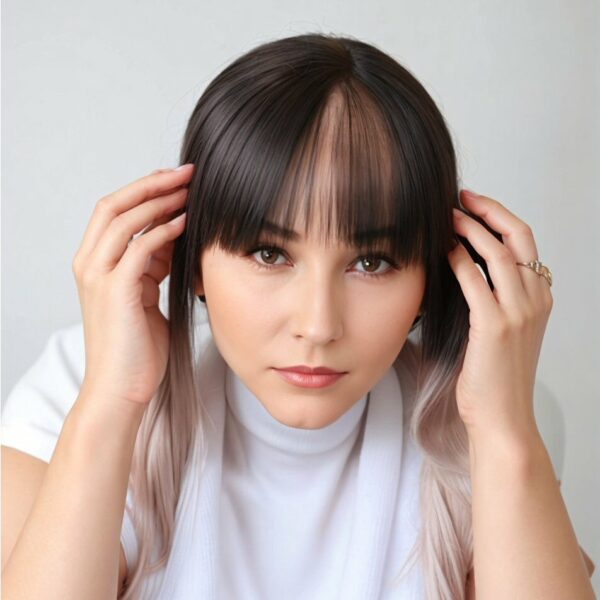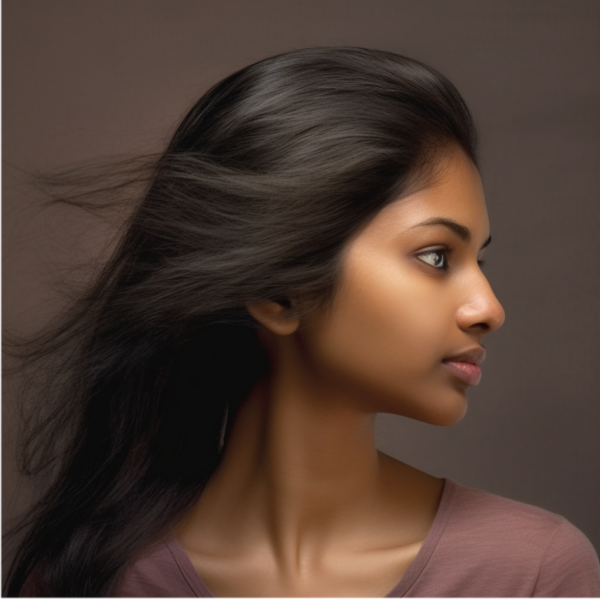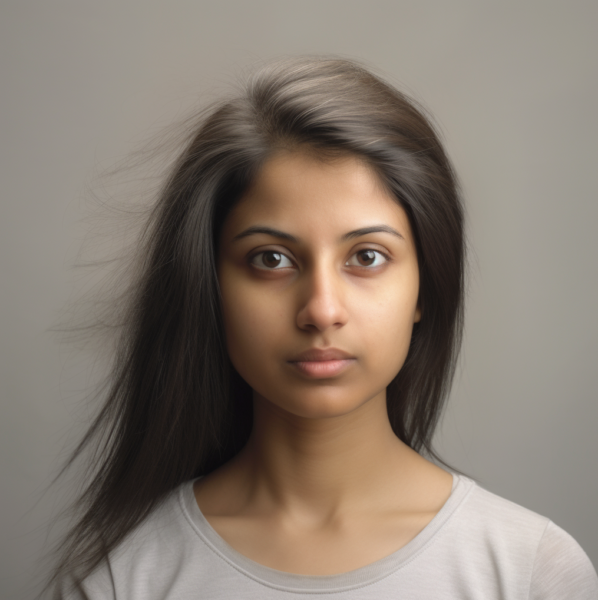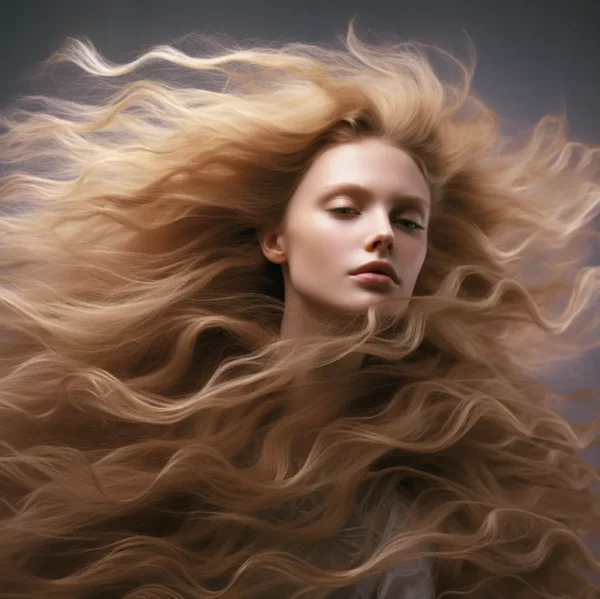Hair bangs, also known as a fringe in some parts of the world, refers to a shaped cutting of the front part of the scalp hair so that it lies over the forehead. Thin hair bangs are characterized by a lower density of hair follicles, leading to a more “transparent” look. This can be a natural attribute of one’s hair or a result of hair thinning due to factors like aging, stress, and sometimes nutritional deficiencies. Regardless of the cause, the goal with thin hair bangs is to create the illusion of thickness and volume while maintaining hair health.
Bang Hair Styles
Bang Cuts: Bangs can be cut in various ways – straight across the forehead at or above the eyebrows, can be longer on the sides, feathered, layered, or styled in many different ways. The length and style of the bangs can dramatically affect the appearance of one’s face, highlighting certain features or altering perceived face shape.
Bangs can be adapted to suit many hair types, from thick and curly to thin and straight, and can be styled to match various fashion trends or personal preferences. They can serve multiple purposes, such as framing the face, changing one’s look without altering the length of the rest of the hair, or covering forehead lines or scars.
The versatility of bangs allows for a wide range of styles, including but not limited to:
Straight-across Bangs : Cut straight across the forehead. This style can vary in thickness and length and is often used to make a bold statement or to give a more youthful appearance.Side-swept Bangs : Styled to sweep across the forehead from one side to the other. This type is versatile and can flatter many face shapes.Wispy Bangs : Thinner, lighter bangs that give a softer, less dramatic look. They can add texture and movement to the hair.Curtain Bangs : Parted down the middle and swept to each side, framing the face like a curtain. This retro-inspired style has seen a resurgence in popularity and suits a wide range of face shapes and hair textures.Layered Bangs : Incorporate layers for added texture and volume, suitable for achieving a more dynamic, textured look.Choosing the right type of bangs depends on several factors, including face shape, hair type, and personal style preferences. Proper maintenance and regular trims are also essential to keep bangs looking their best, as they can quickly lose shape as they grow out.
Styling Thin Hair Bangs
Choosing the Right Type of Bangs for Thin Hair : Not all bang styles are suitable for thin hair. Light, wispy bangs or side-swept bangs can look more natural and are easier to manage than thick, blunt cuts. Layered bangs can also add volume and give the illusion of thickness.
Hair Bang Length: Also consider the length of the hair bangs. Long bangs are heavier and tend to lay flat against the skin. Shorter bangs are lighter and look like they have more volume. There is a compromise to be made of course, between the desired length of the bangs and the desired volume.
Blow-Drying Techniques : Proper blow-drying can make a significant difference. Use a round brush to lift the bangs at the roots while blow-drying to add volume. Directing the airflow from above can also help to avoid flattening the hair against the skin.
Creative Styling : Experimenting with headbands, clips, or different partings can also camouflage thinning areas and add an element of style to your look.
Use of Volumizing Products : Lightweight volumizing mousses or sprays can be applied to the roots before styling to help lift the hair without weighing it down. Avoid heavy creams or oils, which can make thin hair look greasier and flatter.
Cosmetic Treatment and Care for Thin Hair Bangs
Gentle Hair Care Practices : Thin hair is more susceptible to breakage, so gentle handling is crucial. Use a soft brush or comb, be gentle with your hair, avoid excessive heat styling, and if possible, it may be better to let your bangs air-dry. Opt for sulfate-free shampoos and conditioners, which are less damaging to the hair (and less irritating to scalp skin).
Regular Trims : Keeping your bangs trimmed can not only maintain the shape, but also remove split ends, encouraging healthier hair growth. Even if you’re growing your bangs out, a slight trim every 6-8 weeks can make a big difference.
Professional Treatments : For those seeking more significant changes, professional treatments such as keratin complex treatments and volumizing fillers can be considered. While there are some home treatments available, best results tend to be obtained by going to a professional hair salon.
Hair Dye Part One: The process of bleaching and applying hair dye chemicals can result in the hair looking a little thicker. Notably, natural henna hair dye has the unusual property of coating the hair and changing the color on the outside. This coating can also make the hair a little thicker. However, there are risks with both synthetic and natural hair dyes. Chemicals are damaging to the hair and can make it look less healthy and over-processed. Also, henna dye is a plant extract and some people can be allergic to the dye. For all hair dyes, whether synthetic or natural, a patch test should be done first to make sure there is no adverse reaction to the ingredients.
Hair Dye Part Two: The contrast of dark hair against very light skin – and equally, light hair against very dark skin – accentuates the hair. This might seem like a good thing on first consideration, but if you have thin hair, the thinness is accentuated. Professional stylists tend to suggest selecting a hair dye color that reduces the degree of contrast between the hair and skin color. This can make thin hair less noticeable. Consulting with a professional colorist can help determine the best color for your hair and skin type.
Clinical Treatment and Care for Thin Hair Bangs
Nutritional Support : Hair health is deeply connected to nutrition. Ensuring a diet rich in proteins, vitamins (especially B vitamins), biotin, zinc, iron, and omega-3 fatty acids can support hair growth and improve hair thickness. Supplements may be beneficial, but should be taken under the guidance of a healthcare professional.
Minoxidil: Some people with thin hair look to treatments to stimulate thicker hair growth. Minoxidil is one product available over the counter in several countries including the USA, Canada, and the UK. Minoxidil products are direct hair growth stimulators. While they are generally used for pattern hair loss, dermatologists and trichologists do sometimes use them for thinning hair, as with patients that have telogen effluvium. However, there are risks and the potential for side effects with minoxidil use. Minoxidil tends to stimulate some hair shedding on first use (hair follicles have to shed old hair, and grow new hair in response to the minoxidil). Minoxidil doesn’t work for everyone, and some women experience hair growth beyond the area of application (including on the cheeks). Minoxidil is best considered under the guidance of a healthcare professional.
Hair Transplants: For significantly thinning hair, a hair transplant may be a consideration. People don’t have to have pattern hair loss to be eligible for a hair transplant. People with naturally thin hair may also benefit from a limited transplant. The objective is to infill a thin hairline; this can be done by taking follicles from the back of the scalp and transplanting them into and just behind the hair line. There are risks of course. The hairline is the most noticeable part of persons scalp hair. To get a natural-looking hairline with transplanted hair requires good expertise on the part of the transplant surgeon. The best (who usually charge accordingly) can produce a hairline that is undetectable from a natural hairline. However, there are transplant surgeons with less expertise and the result can be unnatural and even doll-like in appearance. As always, consult with a hair care professional to determine the best course of action.
Alternative Solutions
Hair Extensions and Toppers : For instant volume, clip-in hair extensions or toppers designed specifically for bangs can be an effective solution. These should be used sparingly to prevent stress on natural hair follicles. The risk with long term use is the clips and weight of the extensions pull out the natural hair making hair bangs look even thinner.
Temporary Hair Fibers : Colored, keratin hair fibers can be sprinkled onto the scalp and hair to create the appearance of fuller bangs and more hair volume in general. They are usually electrostatically charged particles, so they “stick” on the surface of the hair fiber to make it look thicker. Some of these treatments come with a coating spray to help stick the fibers in lace for longer. However, these fibers are only a temporary solution for quite short term use, but they are easy to apply and can be perfect for special occasions.
Conclusion : While thin hair bangs may require a bit more effort and care, the right approach can turn them into a stylish and attractive feature. By choosing suitable styles, employing gentle hair care practices, and possibly integrating professional treatments or nutritional support, it may be possible to achieve fuller-looking bangs that complement your overall hairstyle. Remember, the key is to focus on hair health, as healthy hair is the foundation of any great style.
Bibliography
11711645 {11711645:QZAG5PR6},{11711645:8KH3CCA8},{11711645:9DZ2QE7J},{11711645:ZEHFR487},{11711645:P988EWIH},{11711645:4T53SU38},{11711645:8CIQZZCN},{11711645:3NFVIDMV},{11711645:CDITWHQB},{11711645:V8IM26MI},{11711645:FNWKRNVT},{11711645:BA87T97H},{11711645:S7FDJB9C},{11711645:QH3ZIND7} 1 vancouver 50 date asc 1151 https://www.keratin.com/wp-content/plugins/zotpress/ %7B%22status%22%3A%22success%22%2C%22updateneeded%22%3Afalse%2C%22instance%22%3Afalse%2C%22meta%22%3A%7B%22request_last%22%3A0%2C%22request_next%22%3A0%2C%22used_cache%22%3Atrue%7D%2C%22data%22%3A%5B%7B%22key%22%3A%22ZEHFR487%22%2C%22library%22%3A%7B%22id%22%3A11711645%7D%2C%22meta%22%3A%7B%22creatorSummary%22%3A%22Dinh%20and%20Sinclair%22%2C%22parsedDate%22%3A%222007%22%2C%22numChildren%22%3A0%7D%2C%22bib%22%3A%22%3Cdiv%20class%3D%5C%22csl-bib-body%5C%22%20style%3D%5C%22line-height%3A%201.35%3B%20%5C%22%3E%5Cn%20%20%3Cdiv%20class%3D%5C%22csl-entry%5C%22%20style%3D%5C%22clear%3A%20left%3B%20%5C%22%3E%5Cn%20%20%20%20%3Cdiv%20class%3D%5C%22csl-left-margin%5C%22%20style%3D%5C%22float%3A%20left%3B%20padding-right%3A%200.5em%3B%20text-align%3A%20right%3B%20width%3A%201em%3B%5C%22%3E1.%3C%5C%2Fdiv%3E%3Cdiv%20class%3D%5C%22csl-right-inline%5C%22%20style%3D%5C%22margin%3A%200%20.4em%200%201.5em%3B%5C%22%3EDinh%20QQ%2C%20Sinclair%20R.%20Female%20pattern%20hair%20loss%3A%20current%20treatment%20concepts.%20Clin%20Interv%20Aging.%202007%3B2%282%29%3A189%26%23x2013%3B99.%3C%5C%2Fdiv%3E%5Cn%20%20%20%3C%5C%2Fdiv%3E%5Cn%3C%5C%2Fdiv%3E%22%2C%22data%22%3A%7B%22itemType%22%3A%22journalArticle%22%2C%22title%22%3A%22Female%20pattern%20hair%20loss%3A%20current%20treatment%20concepts%22%2C%22creators%22%3A%5B%7B%22creatorType%22%3A%22author%22%2C%22firstName%22%3A%22Quan%20Q.%22%2C%22lastName%22%3A%22Dinh%22%7D%2C%7B%22creatorType%22%3A%22author%22%2C%22firstName%22%3A%22Rodney%22%2C%22lastName%22%3A%22Sinclair%22%7D%5D%2C%22abstractNote%22%3A%22Fewer%20than%2045%25%20of%20women%20go%20through%20life%20with%20a%20full%20head%20of%20hair.%20Female%20pattern%20hair%20loss%20is%20the%20commonest%20cause%20of%20hair%20loss%20in%20women%20and%20prevalence%20increases%20with%20advancing%20age.%20Affected%20women%20may%20experience%20psychological%20distress%20and%20impaired%20social%20functioning.%20In%20most%20cases%20the%20diagnosis%20can%20be%20made%20clinically%20and%20the%20condition%20treated%20medically.%20While%20many%20women%20using%20oral%20antiandrogens%20and%20topical%20minoxidil%20will%20regrow%20some%20hair%2C%20early%20diagnosis%20and%20initiation%20of%20treatment%20is%20desirable%20as%20these%20treatments%20are%20more%20effective%20at%20arresting%20progression%20of%20hair%20loss%20than%20stimulating%20regrowth.%20Adjunctive%20nonpharmacological%20treatment%20modalities%20such%20as%20counseling%2C%20cosmetic%20camouflage%20and%20hair%20transplantation%20are%20important%20measures%20for%20some%20patients.%20The%20histology%20of%20female%20pattern%20hair%20loss%20is%20identical%20to%20that%20of%20male%20androgenetic%20alopecia.%20While%20the%20clinical%20pattern%20of%20the%20hair%20loss%20differs%20between%20men%2C%20the%20response%20to%20oral%20antiandrogens%20suggests%20that%20female%20pattern%20hair%20loss%20is%20an%20androgen%20dependant%20condition%2C%20at%20least%20in%20the%20majority%20of%20cases.%20Female%20pattern%20hair%20loss%20is%20a%20chronic%20progressive%20condition.%20All%20treatments%20need%20to%20be%20continued%20to%20maintain%20the%20effect.%20An%20initial%20therapeutic%20response%20often%20takes%2012%20or%20even%2024%20months.%20Given%20this%20delay%2C%20monitoring%20for%20treatment%20effect%20through%20clinical%20photography%20or%20standardized%20clinical%20severity%20scales%20is%20helpful.%22%2C%22date%22%3A%222007%22%2C%22language%22%3A%22eng%22%2C%22DOI%22%3A%22%22%2C%22ISSN%22%3A%221176-9092%22%2C%22url%22%3A%22%22%2C%22collections%22%3A%5B%22D7RRATQQ%22%5D%2C%22dateModified%22%3A%222024-02-02T15%3A54%3A20Z%22%7D%7D%2C%7B%22key%22%3A%22S7FDJB9C%22%2C%22library%22%3A%7B%22id%22%3A11711645%7D%2C%22meta%22%3A%7B%22creatorSummary%22%3A%22Yang%20et%20al.%22%2C%22parsedDate%22%3A%222009-01%22%2C%22numChildren%22%3A0%7D%2C%22bib%22%3A%22%3Cdiv%20class%3D%5C%22csl-bib-body%5C%22%20style%3D%5C%22line-height%3A%201.35%3B%20%5C%22%3E%5Cn%20%20%3Cdiv%20class%3D%5C%22csl-entry%5C%22%20style%3D%5C%22clear%3A%20left%3B%20%5C%22%3E%5Cn%20%20%20%20%3Cdiv%20class%3D%5C%22csl-left-margin%5C%22%20style%3D%5C%22float%3A%20left%3B%20padding-right%3A%200.5em%3B%20text-align%3A%20right%3B%20width%3A%201em%3B%5C%22%3E1.%3C%5C%2Fdiv%3E%3Cdiv%20class%3D%5C%22csl-right-inline%5C%22%20style%3D%5C%22margin%3A%200%20.4em%200%201.5em%3B%5C%22%3EYang%20A%2C%20Iorizzo%20M%2C%20Vincenzi%20C%2C%20Tosti%20A.%20Hair%20extensions%3A%20a%20concerning%20cause%20of%20hair%20disorders.%20Br%20J%20Dermatol.%202009%20Jan%3B160%281%29%3A207%26%23x2013%3B9.%3C%5C%2Fdiv%3E%5Cn%20%20%20%3C%5C%2Fdiv%3E%5Cn%3C%5C%2Fdiv%3E%22%2C%22data%22%3A%7B%22itemType%22%3A%22journalArticle%22%2C%22title%22%3A%22Hair%20extensions%3A%20a%20concerning%20cause%20of%20hair%20disorders%22%2C%22creators%22%3A%5B%7B%22creatorType%22%3A%22author%22%2C%22firstName%22%3A%22A.%22%2C%22lastName%22%3A%22Yang%22%7D%2C%7B%22creatorType%22%3A%22author%22%2C%22firstName%22%3A%22M.%22%2C%22lastName%22%3A%22Iorizzo%22%7D%2C%7B%22creatorType%22%3A%22author%22%2C%22firstName%22%3A%22C.%22%2C%22lastName%22%3A%22Vincenzi%22%7D%2C%7B%22creatorType%22%3A%22author%22%2C%22firstName%22%3A%22A.%22%2C%22lastName%22%3A%22Tosti%22%7D%5D%2C%22abstractNote%22%3A%22%22%2C%22date%22%3A%222009-01%22%2C%22language%22%3A%22eng%22%2C%22DOI%22%3A%2210.1111%5C%2Fj.1365-2133.2008.08924.x%22%2C%22ISSN%22%3A%221365-2133%22%2C%22url%22%3A%22%22%2C%22collections%22%3A%5B%22D7RRATQQ%22%5D%2C%22dateModified%22%3A%222024-02-02T16%3A10%3A07Z%22%7D%7D%2C%7B%22key%22%3A%228CIQZZCN%22%2C%22library%22%3A%7B%22id%22%3A11711645%7D%2C%22meta%22%3A%7B%22creatorSummary%22%3A%22Draelos%22%2C%22parsedDate%22%3A%222011%22%2C%22numChildren%22%3A0%7D%2C%22bib%22%3A%22%3Cdiv%20class%3D%5C%22csl-bib-body%5C%22%20style%3D%5C%22line-height%3A%201.35%3B%20%5C%22%3E%5Cn%20%20%3Cdiv%20class%3D%5C%22csl-entry%5C%22%20style%3D%5C%22clear%3A%20left%3B%20%5C%22%3E%5Cn%20%20%20%20%3Cdiv%20class%3D%5C%22csl-left-margin%5C%22%20style%3D%5C%22float%3A%20left%3B%20padding-right%3A%200.5em%3B%20text-align%3A%20right%3B%20width%3A%201em%3B%5C%22%3E1.%3C%5C%2Fdiv%3E%3Cdiv%20class%3D%5C%22csl-right-inline%5C%22%20style%3D%5C%22margin%3A%200%20.4em%200%201.5em%3B%5C%22%3EDraelos%20ZD.%20Camouflage%20technique%20for%20alopecia%20areata%3A%20What%20is%20a%20patient%20to%20do%3F%20Dermatol%20Ther.%202011%3B24%283%29%3A305%26%23x2013%3B10.%3C%5C%2Fdiv%3E%5Cn%20%20%20%3C%5C%2Fdiv%3E%5Cn%3C%5C%2Fdiv%3E%22%2C%22data%22%3A%7B%22itemType%22%3A%22journalArticle%22%2C%22title%22%3A%22Camouflage%20technique%20for%20alopecia%20areata%3A%20What%20is%20a%20patient%20to%20do%3F%22%2C%22creators%22%3A%5B%7B%22creatorType%22%3A%22author%22%2C%22firstName%22%3A%22Zoe%20Diana%22%2C%22lastName%22%3A%22Draelos%22%7D%5D%2C%22abstractNote%22%3A%22Alopecia%20areata%20is%20a%20devastating%20condition%20for%20any%20patient%20as%20hair%20is%20a%20prized%20component%20of%20human%20beauty.%20Poems%20and%20folktales%20have%20been%20written%20about%20long%2C%20luxuriant%2C%20female%2C%20golden%2C%20and%20chestnut%20hair%2C%20and%20even%20the%20Bible%20discusses%20the%20diminishment%20of%20male%20power%20when%20hair%20is%20lost.%20The%20question%20arises%20as%20to%20whether%20anyone%20can%20be%20beautiful%20without%20hair.%20The%20answer%20is%20a%20definite%20yes.%20No%20one%20can%20dispute%20the%20virility%20of%20a%20shaved%20male%20head%2C%20indicating%20the%20absence%20of%20hair%20can%20make%20a%20strikingly%20beautiful%20fashion%20statement.%20This%20is%20sadly%20not%20the%20case%20for%20women.%20With%20hair%20loss%2C%20the%20decision%20can%20be%20made%20to%20readjust%20to%20a%20personal%20image%20devoid%20of%20hair%2C%20yet%20there%20are%20those%20who%20require%20hair%20for%20self-confidence%20or%20simply%20to%20fit%20in%20with%20the%20rest%20of%20society.%20This%20article%20discusses%20the%20currently%20available%20options%20for%20those%20who%20wish%20to%20pursue%20camouflage%20of%20hair%20loss%20involving%20the%20scalp%2C%20eyebrows%2C%20and%20eyelashes.%22%2C%22date%22%3A%222011%22%2C%22language%22%3A%22eng%22%2C%22DOI%22%3A%2210.1111%5C%2Fj.1529-8019.2011.01417.x%22%2C%22ISSN%22%3A%221529-8019%22%2C%22url%22%3A%22%22%2C%22collections%22%3A%5B%22D7RRATQQ%22%5D%2C%22dateModified%22%3A%222024-02-02T15%3A54%3A52Z%22%7D%7D%2C%7B%22key%22%3A%22V8IM26MI%22%2C%22library%22%3A%7B%22id%22%3A11711645%7D%2C%22meta%22%3A%7B%22creatorSummary%22%3A%22Sinclair%20et%20al.%22%2C%22parsedDate%22%3A%222011-12%22%2C%22numChildren%22%3A0%7D%2C%22bib%22%3A%22%3Cdiv%20class%3D%5C%22csl-bib-body%5C%22%20style%3D%5C%22line-height%3A%201.35%3B%20%5C%22%3E%5Cn%20%20%3Cdiv%20class%3D%5C%22csl-entry%5C%22%20style%3D%5C%22clear%3A%20left%3B%20%5C%22%3E%5Cn%20%20%20%20%3Cdiv%20class%3D%5C%22csl-left-margin%5C%22%20style%3D%5C%22float%3A%20left%3B%20padding-right%3A%200.5em%3B%20text-align%3A%20right%3B%20width%3A%201em%3B%5C%22%3E1.%3C%5C%2Fdiv%3E%3Cdiv%20class%3D%5C%22csl-right-inline%5C%22%20style%3D%5C%22margin%3A%200%20.4em%200%201.5em%3B%5C%22%3ESinclair%20R%2C%20Patel%20M%2C%20Dawson%20TL%2C%20Yazdabadi%20A%2C%20Yip%20L%2C%20Perez%20A%2C%20et%20al.%20Hair%20loss%20in%20women%3A%20medical%20and%20cosmetic%20approaches%20to%20increase%20scalp%20hair%20fullness.%20Br%20J%20Dermatol.%202011%20Dec%3B165%20Suppl%203%3A12%26%23x2013%3B8.%3C%5C%2Fdiv%3E%5Cn%20%20%20%3C%5C%2Fdiv%3E%5Cn%3C%5C%2Fdiv%3E%22%2C%22data%22%3A%7B%22itemType%22%3A%22journalArticle%22%2C%22title%22%3A%22Hair%20loss%20in%20women%3A%20medical%20and%20cosmetic%20approaches%20to%20increase%20scalp%20hair%20fullness%22%2C%22creators%22%3A%5B%7B%22creatorType%22%3A%22author%22%2C%22firstName%22%3A%22R.%22%2C%22lastName%22%3A%22Sinclair%22%7D%2C%7B%22creatorType%22%3A%22author%22%2C%22firstName%22%3A%22M.%22%2C%22lastName%22%3A%22Patel%22%7D%2C%7B%22creatorType%22%3A%22author%22%2C%22firstName%22%3A%22T.%20L.%22%2C%22lastName%22%3A%22Dawson%22%7D%2C%7B%22creatorType%22%3A%22author%22%2C%22firstName%22%3A%22A.%22%2C%22lastName%22%3A%22Yazdabadi%22%7D%2C%7B%22creatorType%22%3A%22author%22%2C%22firstName%22%3A%22L.%22%2C%22lastName%22%3A%22Yip%22%7D%2C%7B%22creatorType%22%3A%22author%22%2C%22firstName%22%3A%22A.%22%2C%22lastName%22%3A%22Perez%22%7D%2C%7B%22creatorType%22%3A%22author%22%2C%22firstName%22%3A%22N.%20W.%22%2C%22lastName%22%3A%22Rufaut%22%7D%5D%2C%22abstractNote%22%3A%22Androgenetic%20alopecia%20affects%20both%20men%20and%20women.%20In%20men%20it%20produces%20male%20pattern%20hair%20loss%20with%20bitemporal%20recession%20and%20vertex%20baldness.%20In%20women%20it%20produces%20female%20pattern%20hair%20loss%20%28FPHL%29%20with%20diffuse%20alopecia%20over%20the%20mid-frontal%20scalp.%20FPHL%20occurs%20as%20a%20result%20of%20nonuniform%20hair%20follicle%20miniaturization%20within%20follicular%20units.%20Diffuse%20alopecia%20is%20produced%20by%20a%20reduction%20in%20the%20number%20of%20terminal%20fibres%20per%20follicular%20unit.%20Baldness%20occurs%20only%20when%20all%20hairs%20within%20the%20follicular%20units%20are%20miniaturized%20and%20is%20a%20relatively%20late%20event%20in%20women.%20The%20concepts%20of%20follicular%20units%20and%20primary%20and%20secondary%20hair%20follicles%20within%20follicular%20units%20are%20well%20established%20in%20comparative%20mammalian%20studies%2C%20particularly%20in%20sheep.%20However%2C%20discovery%20of%20these%20structures%20in%20the%20human%20scalp%20hair%20and%20investigation%20of%20the%20changes%20in%20follicular%20unit%20anatomy%20during%20the%20development%20of%20androgenetic%20alopecia%20have%20provided%20a%20clearer%20understanding%20of%20the%20early%20stages%20of%20androgenetic%20alopecia%20and%20how%20the%20male%20and%20female%20patterns%20of%20hair%20loss%20are%20related.%20FPHL%20is%20the%20most%20common%20cause%20of%20alopecia%20in%20women%20and%20approximately%20one-third%20of%20adult%20caucasian%20women%20experience%20hair%20loss.%20The%20impact%20of%20FPHL%20is%20predominantly%20psychological.%20While%20men%20anticipate%20age-related%20hair%20loss%2C%20hair%20loss%20in%20women%20is%20usually%20unexpected%20and%20unwelcome%20at%20any%20age.%20Treatment%20options%20to%20arrest%20hair%20loss%20progression%20and%20stimulate%20partial%20hair%20regrowth%20for%20FPHL%20include%20the%20androgen%20receptor%20antagonists%20spironolactone%20and%20cyproterone%20acetate%2C%20the%205%5Cu03b1-reductase%20inhibitor%20finasteride%20and%20the%20androgen-independent%20hair%20growth%20stimulator%20minoxidil.%20These%20treatments%20appear%20to%20work%20best%20when%20initiated%20early.%20Hair%20transplantation%20should%20be%20considered%20in%20advanced%20FPHL%20that%20is%20resistant%20to%20medical%20treatments.%20Hair%20transplantation%20requires%20well-preserved%20hair%20growth%20over%20the%20occipital%20donor%20area.%20The%20psychological%20impact%20of%20FPHL%20may%20also%20be%20reduced%20by%20cosmetic%20products%20that%20improve%20the%20appearance%20of%20the%20hair.%20These%20agents%20work%20to%20minimize%20hair%20fibre%20breakage%2C%20improve%20hair%20volume%20or%20conceal%20visible%20bald%20scalp.%22%2C%22date%22%3A%222011-12%22%2C%22language%22%3A%22eng%22%2C%22DOI%22%3A%2210.1111%5C%2Fj.1365-2133.2011.10630.x%22%2C%22ISSN%22%3A%221365-2133%22%2C%22url%22%3A%22%22%2C%22collections%22%3A%5B%22D7RRATQQ%22%5D%2C%22dateModified%22%3A%222024-02-02T16%3A04%3A37Z%22%7D%7D%2C%7B%22key%22%3A%22QZAG5PR6%22%2C%22library%22%3A%7B%22id%22%3A11711645%7D%2C%22meta%22%3A%7B%22creatorSummary%22%3A%22Banka%20et%20al.%22%2C%22parsedDate%22%3A%222012%22%2C%22numChildren%22%3A0%7D%2C%22bib%22%3A%22%3Cdiv%20class%3D%5C%22csl-bib-body%5C%22%20style%3D%5C%22line-height%3A%201.35%3B%20%5C%22%3E%5Cn%20%20%3Cdiv%20class%3D%5C%22csl-entry%5C%22%20style%3D%5C%22clear%3A%20left%3B%20%5C%22%3E%5Cn%20%20%20%20%3Cdiv%20class%3D%5C%22csl-left-margin%5C%22%20style%3D%5C%22float%3A%20left%3B%20padding-right%3A%200.5em%3B%20text-align%3A%20right%3B%20width%3A%201em%3B%5C%22%3E1.%3C%5C%2Fdiv%3E%3Cdiv%20class%3D%5C%22csl-right-inline%5C%22%20style%3D%5C%22margin%3A%200%20.4em%200%201.5em%3B%5C%22%3EBanka%20N%2C%20Bunagan%20MJK%2C%20Dubrule%20Y%2C%20Shapiro%20J.%20Wigs%20and%20hairpieces%3A%20evaluating%20dermatologic%20issues.%20Dermatol%20Ther.%202012%3B25%283%29%3A260%26%23x2013%3B6.%3C%5C%2Fdiv%3E%5Cn%20%20%20%3C%5C%2Fdiv%3E%5Cn%3C%5C%2Fdiv%3E%22%2C%22data%22%3A%7B%22itemType%22%3A%22journalArticle%22%2C%22title%22%3A%22Wigs%20and%20hairpieces%3A%20evaluating%20dermatologic%20issues%22%2C%22creators%22%3A%5B%7B%22creatorType%22%3A%22author%22%2C%22firstName%22%3A%22Nusrat%22%2C%22lastName%22%3A%22Banka%22%7D%2C%7B%22creatorType%22%3A%22author%22%2C%22firstName%22%3A%22M.%20J.%20Kristine%22%2C%22lastName%22%3A%22Bunagan%22%7D%2C%7B%22creatorType%22%3A%22author%22%2C%22firstName%22%3A%22Yvonne%22%2C%22lastName%22%3A%22Dubrule%22%7D%2C%7B%22creatorType%22%3A%22author%22%2C%22firstName%22%3A%22Jerry%22%2C%22lastName%22%3A%22Shapiro%22%7D%5D%2C%22abstractNote%22%3A%22Hair%20is%20an%20important%20feature%20of%20self-image%2C%20and%20hair%20loss%20can%20have%20a%20devastating%20impact%20on%20a%20person%27s%20pychological%20well-being.%20In%20recent%20years%2C%20there%20has%20been%20an%20explosion%20of%20research%20in%20the%20understanding%20of%20various%20hair%20disorders%2C%20but%20unfortunately%20there%20has%20not%20been%20a%20major%20breakthrough%20and%20not%20much%20has%20changed%20in%20terms%20of%20therapeutic%20options%20available%20to%20patients%20with%20extensive%20hair%20loss.%20As%20professionals%2C%20we%20need%20to%20understand%20the%20social%20significance%20of%20hair%20in%20relation%20to%20a%20person%27s%20outward%20presentation%20and%20social%20interactions.%20We%20must%20minimize%20the%20distress%20alopecia%20can%20cause%20by%20providing%20up-to-date%20information%20to%20enable%20them%20to%20prepare%20for%20and%20minimize%20the%20psychological%20consequences%20of%20hair%20loss.%22%2C%22date%22%3A%222012%22%2C%22language%22%3A%22eng%22%2C%22DOI%22%3A%2210.1111%5C%2Fj.1529-8019.2012.01506.x%22%2C%22ISSN%22%3A%221529-8019%22%2C%22url%22%3A%22%22%2C%22collections%22%3A%5B%22D7RRATQQ%22%5D%2C%22dateModified%22%3A%222024-02-02T16%3A11%3A31Z%22%7D%7D%2C%7B%22key%22%3A%22P988EWIH%22%2C%22library%22%3A%7B%22id%22%3A11711645%7D%2C%22meta%22%3A%7B%22creatorSummary%22%3A%22Donovan%20et%20al.%22%2C%22parsedDate%22%3A%222012-08-15%22%2C%22numChildren%22%3A0%7D%2C%22bib%22%3A%22%3Cdiv%20class%3D%5C%22csl-bib-body%5C%22%20style%3D%5C%22line-height%3A%201.35%3B%20%5C%22%3E%5Cn%20%20%3Cdiv%20class%3D%5C%22csl-entry%5C%22%20style%3D%5C%22clear%3A%20left%3B%20%5C%22%3E%5Cn%20%20%20%20%3Cdiv%20class%3D%5C%22csl-left-margin%5C%22%20style%3D%5C%22float%3A%20left%3B%20padding-right%3A%200.5em%3B%20text-align%3A%20right%3B%20width%3A%201em%3B%5C%22%3E1.%3C%5C%2Fdiv%3E%3Cdiv%20class%3D%5C%22csl-right-inline%5C%22%20style%3D%5C%22margin%3A%200%20.4em%200%201.5em%3B%5C%22%3EDonovan%20JCH%2C%20Shapiro%20RL%2C%20Shapiro%20P%2C%20Zupan%20M%2C%20Pierre-Louis%20M%2C%20Hordinsky%20MK.%20A%20review%20of%20scalp%20camouflaging%20agents%20and%20prostheses%20for%20individuals%20with%20hair%20loss.%20Dermatol%20Online%20J.%202012%20Aug%2015%3B18%288%29%3A1.%3C%5C%2Fdiv%3E%5Cn%20%20%20%3C%5C%2Fdiv%3E%5Cn%3C%5C%2Fdiv%3E%22%2C%22data%22%3A%7B%22itemType%22%3A%22journalArticle%22%2C%22title%22%3A%22A%20review%20of%20scalp%20camouflaging%20agents%20and%20prostheses%20for%20individuals%20with%20hair%20loss%22%2C%22creators%22%3A%5B%7B%22creatorType%22%3A%22author%22%2C%22firstName%22%3A%22Jeff%20C.%20H.%22%2C%22lastName%22%3A%22Donovan%22%7D%2C%7B%22creatorType%22%3A%22author%22%2C%22firstName%22%3A%22Ron%20L.%22%2C%22lastName%22%3A%22Shapiro%22%7D%2C%7B%22creatorType%22%3A%22author%22%2C%22firstName%22%3A%22Paul%22%2C%22lastName%22%3A%22Shapiro%22%7D%2C%7B%22creatorType%22%3A%22author%22%2C%22firstName%22%3A%22Matt%22%2C%22lastName%22%3A%22Zupan%22%7D%2C%7B%22creatorType%22%3A%22author%22%2C%22firstName%22%3A%22Margareth%22%2C%22lastName%22%3A%22Pierre-Louis%22%7D%2C%7B%22creatorType%22%3A%22author%22%2C%22firstName%22%3A%22Maria%20K.%22%2C%22lastName%22%3A%22Hordinsky%22%7D%5D%2C%22abstractNote%22%3A%22Hair%20loss%20is%20a%20common%20problem%20for%20both%20men%20and%20women%20and%20may%20impact%20negatively%20on%20self-esteem.%20A%20variety%20of%20medical%20and%20surgical%20treatment%20options%20are%20available%20depending%20on%20the%20type%20of%20alopecia.%20Many%20patients%20also%20seek%20the%20advice%20of%20their%20physicians%20about%20options%20to%20hide%20or%20reduce%20the%20appearance%20of%20hair%20loss%20with%20hair%20prostheses%20%28wigs%2C%20hairpieces%2C%20and%20extensions%29%20or%20hair%20camouflaging%20agents%20%28hair%20fibers%2C%20powder%20cakes%2C%20lotions%2C%20sprays%2C%20hair%20crayons%2C%20and%20scalp%20tattooing%29.%20Herein%2C%20we%20review%20current%20methods%20to%20hide%20or%20reduce%20the%20appearance%20of%20hair%20loss%20and%20discuss%20their%20associated%20costs%2C%20advantages%2C%20and%20disadvantages.%20Knowledge%20of%20products%20available%20to%20cover%20scalp%2C%20eyebrow%2C%20and%20eyelash%20hair%20loss%20may%20not%20only%20better%20equip%20clinicians%20to%20respond%20to%20questions%20from%20concerned%20patients%2C%20but%20may%20provide%20additional%20options%20to%20help%20these%20patients%20best%20cope%20with%20their%20hair%20loss.%22%2C%22date%22%3A%222012-08-15%22%2C%22language%22%3A%22eng%22%2C%22DOI%22%3A%22%22%2C%22ISSN%22%3A%221087-2108%22%2C%22url%22%3A%22%22%2C%22collections%22%3A%5B%22D7RRATQQ%22%5D%2C%22dateModified%22%3A%222024-02-02T16%3A09%3A49Z%22%7D%7D%2C%7B%22key%22%3A%224T53SU38%22%2C%22library%22%3A%7B%22id%22%3A11711645%7D%2C%22meta%22%3A%7B%22creatorSummary%22%3A%22Draelos%22%2C%22parsedDate%22%3A%222013-01%22%2C%22numChildren%22%3A0%7D%2C%22bib%22%3A%22%3Cdiv%20class%3D%5C%22csl-bib-body%5C%22%20style%3D%5C%22line-height%3A%201.35%3B%20%5C%22%3E%5Cn%20%20%3Cdiv%20class%3D%5C%22csl-entry%5C%22%20style%3D%5C%22clear%3A%20left%3B%20%5C%22%3E%5Cn%20%20%20%20%3Cdiv%20class%3D%5C%22csl-left-margin%5C%22%20style%3D%5C%22float%3A%20left%3B%20padding-right%3A%200.5em%3B%20text-align%3A%20right%3B%20width%3A%201em%3B%5C%22%3E1.%3C%5C%2Fdiv%3E%3Cdiv%20class%3D%5C%22csl-right-inline%5C%22%20style%3D%5C%22margin%3A%200%20.4em%200%201.5em%3B%5C%22%3EDraelos%20ZD.%20Shampoos%2C%20conditioners%2C%20and%20camouflage%20techniques.%20Dermatol%20Clin.%202013%20Jan%3B31%281%29%3A173%26%23x2013%3B8.%3C%5C%2Fdiv%3E%5Cn%20%20%20%3C%5C%2Fdiv%3E%5Cn%3C%5C%2Fdiv%3E%22%2C%22data%22%3A%7B%22itemType%22%3A%22journalArticle%22%2C%22title%22%3A%22Shampoos%2C%20conditioners%2C%20and%20camouflage%20techniques%22%2C%22creators%22%3A%5B%7B%22creatorType%22%3A%22author%22%2C%22firstName%22%3A%22Zoe%20Diana%22%2C%22lastName%22%3A%22Draelos%22%7D%5D%2C%22abstractNote%22%3A%22This%20article%20examines%20hair%20care%20in%20persons%20with%20hair%20loss.%20The%20use%20of%20shampoos%2C%20conditioners%2C%20and%20hair%20styling%20products%20to%20camouflage%20hair%20loss%20is%20discussed.%20Because%20hair%20is%20nonliving%2C%20medical%20treatments%20are%20limited%20to%20only%20inducing%20change%20in%20the%20follicles%20within%20the%20scalp%20skin%20and%20do%20not%20improve%20the%20hair%20loss%20actually%20witnessed%20by%20the%20patient.%20There%20is%20therefore%20a%20need%20to%20accompany%20medical%20treatment%20of%20hair%20loss%20with%20cosmetic%20hair%20treatment%20to%20optimize%20patient%20satisfaction.%22%2C%22date%22%3A%222013-01%22%2C%22language%22%3A%22eng%22%2C%22DOI%22%3A%2210.1016%5C%2Fj.det.2012.08.004%22%2C%22ISSN%22%3A%221558-0520%22%2C%22url%22%3A%22%22%2C%22collections%22%3A%5B%22D7RRATQQ%22%5D%2C%22dateModified%22%3A%222024-02-02T16%3A03%3A23Z%22%7D%7D%2C%7B%22key%22%3A%228KH3CCA8%22%2C%22library%22%3A%7B%22id%22%3A11711645%7D%2C%22meta%22%3A%7B%22creatorSummary%22%3A%22Cossman%20et%20al.%22%2C%22parsedDate%22%3A%222013-12%22%2C%22numChildren%22%3A0%7D%2C%22bib%22%3A%22%3Cdiv%20class%3D%5C%22csl-bib-body%5C%22%20style%3D%5C%22line-height%3A%201.35%3B%20%5C%22%3E%5Cn%20%20%3Cdiv%20class%3D%5C%22csl-entry%5C%22%20style%3D%5C%22clear%3A%20left%3B%20%5C%22%3E%5Cn%20%20%20%20%3Cdiv%20class%3D%5C%22csl-left-margin%5C%22%20style%3D%5C%22float%3A%20left%3B%20padding-right%3A%200.5em%3B%20text-align%3A%20right%3B%20width%3A%201em%3B%5C%22%3E1.%3C%5C%2Fdiv%3E%3Cdiv%20class%3D%5C%22csl-right-inline%5C%22%20style%3D%5C%22margin%3A%200%20.4em%200%201.5em%3B%5C%22%3ECossman%20JP%2C%20Ladizinski%20B%2C%20Lee%20KC.%20Pigmented%20concealing%20powders%20for%20the%20hair%20loss%20patient.%20J%20Cosmet%20Dermatol.%202013%20Dec%3B12%284%29%3A322%26%23x2013%3B4.%3C%5C%2Fdiv%3E%5Cn%20%20%20%3C%5C%2Fdiv%3E%5Cn%3C%5C%2Fdiv%3E%22%2C%22data%22%3A%7B%22itemType%22%3A%22journalArticle%22%2C%22title%22%3A%22Pigmented%20concealing%20powders%20for%20the%20hair%20loss%20patient%22%2C%22creators%22%3A%5B%7B%22creatorType%22%3A%22author%22%2C%22firstName%22%3A%22Jack%20P.%22%2C%22lastName%22%3A%22Cossman%22%7D%2C%7B%22creatorType%22%3A%22author%22%2C%22firstName%22%3A%22Barry%22%2C%22lastName%22%3A%22Ladizinski%22%7D%2C%7B%22creatorType%22%3A%22author%22%2C%22firstName%22%3A%22Kachiu%20C.%22%2C%22lastName%22%3A%22Lee%22%7D%5D%2C%22abstractNote%22%3A%22Patients%20suffering%20from%20alopecia%20may%20experience%20low%20self-esteem%2C%20low%20self-image%2C%20and%20other%20psychological%20consequences.%20While%20medical%20and%20surgical%20options%20for%20treating%20hair%20loss%20exist%2C%20these%20may%20be%20prohibitively%20expensive%20or%20have%20an%20unpredictable%20outcome.%20In%20lieu%20of%20or%20in%20addition%20to%20therapeutic%20approaches%2C%20cosmetic%20options%20have%20long%20been%20an%20approach%20to%20hair%20loss.%20However%2C%20patients%20and%20clinicians%20alike%20often%20regard%20cosmetic%20options%20to%20be%20limited%20to%20hairstyling%20and%20hairpieces%2C%20unaware%20that%20newer%20options%2C%20namely%20pigmented%20concealing%20powders%2C%20may%20offer%20a%20more%20practical%20and%20seemingly%20natural%20camouflage.%20This%20article%20introduces%20the%20clinician%20to%20concealing%20powders%20as%20a%20viable%20option%20for%20the%20hair%20loss%20patient.%22%2C%22date%22%3A%222013-12%22%2C%22language%22%3A%22eng%22%2C%22DOI%22%3A%2210.1111%5C%2Fjocd.12063%22%2C%22ISSN%22%3A%221473-2165%22%2C%22url%22%3A%22%22%2C%22collections%22%3A%5B%22D7RRATQQ%22%5D%2C%22dateModified%22%3A%222024-02-02T16%3A10%3A59Z%22%7D%7D%2C%7B%22key%22%3A%22QH3ZIND7%22%2C%22library%22%3A%7B%22id%22%3A11711645%7D%2C%22meta%22%3A%7B%22creatorSummary%22%3A%22You%20and%20Then%22%2C%22parsedDate%22%3A%222015-02-01%22%2C%22numChildren%22%3A0%7D%2C%22bib%22%3A%22%3Cdiv%20class%3D%5C%22csl-bib-body%5C%22%20style%3D%5C%22line-height%3A%201.35%3B%20%5C%22%3E%5Cn%20%20%3Cdiv%20class%3D%5C%22csl-entry%5C%22%20style%3D%5C%22clear%3A%20left%3B%20%5C%22%3E%5Cn%20%20%20%20%3Cdiv%20class%3D%5C%22csl-left-margin%5C%22%20style%3D%5C%22float%3A%20left%3B%20padding-right%3A%200.5em%3B%20text-align%3A%20right%3B%20width%3A%201em%3B%5C%22%3E1.%3C%5C%2Fdiv%3E%3Cdiv%20class%3D%5C%22csl-right-inline%5C%22%20style%3D%5C%22margin%3A%200%20.4em%200%201.5em%3B%5C%22%3EYou%20K%2C%20Then%20YL.%20Electrostatic%20and%20Dielectric%20Measurements%20for%20Hair%20Building%20Fibers%20from%20DC%20to%20Microwave%20Frequencies.%20World%20Academy%20of%20Science%2C%20Engineering%20and%20Technology%2C%20International%20Journal%20of%20Electrical%2C%20Computer%2C%20Energetic%2C%20Electronic%20and%20Communication%20Engineering.%202015%20Feb%201%3B%3C%5C%2Fdiv%3E%5Cn%20%20%20%3C%5C%2Fdiv%3E%5Cn%3C%5C%2Fdiv%3E%22%2C%22data%22%3A%7B%22itemType%22%3A%22journalArticle%22%2C%22title%22%3A%22Electrostatic%20and%20Dielectric%20Measurements%20for%20Hair%20Building%20Fibers%20from%20DC%20to%20Microwave%20Frequencies%22%2C%22creators%22%3A%5B%7B%22creatorType%22%3A%22author%22%2C%22firstName%22%3A%22K.%22%2C%22lastName%22%3A%22You%22%7D%2C%7B%22creatorType%22%3A%22author%22%2C%22firstName%22%3A%22Y.%20L.%22%2C%22lastName%22%3A%22Then%22%7D%5D%2C%22abstractNote%22%3A%22In%20recent%20years%2C%20the%20hair%20building%20fiber%20has%20become%20popular%2C%20in%20other%20words%2C%20it%20is%20an%20effective%20method%20which%20helps%20people%20who%20suffer%20hair%20loss%20or%20sparse%20hair%20since%20the%20hair%20building%20fiber%20is%20capable%20to%20create%20a%20natural%20look%20of%20simulated%20hair%20rapidly.%20In%20the%20markets%2C%20there%20are%20a%20lot%20of%20hair%20fiber%20brands%20that%20have%20been%20designed%20to%20formulate%20an%20intense%20bond%20with%20hair%20strands%20and%20make%20the%20hair%20appear%20more%20voluminous%20instantly.%20However%2C%20those%20products%20have%20their%20own%20set%20of%20properties.%20Thus%2C%20in%20this%20report%2C%20some%20measurement%20techniques%20are%20proposed%20to%20identify%20those%20products.%20Up%20to%20five%20different%20brands%20of%20hair%20fiber%20are%20tested.%20The%20electrostatic%20and%20dielectric%20properties%20of%20the%20hair%20fibers%20are%20macroscopically%20tested%20using%20design%20DC%20and%20high%20frequency%20microwave%20techniques.%20Besides%2C%20the%20hair%20fibers%20are%20microscopically%20analysis%20by%20magnifying%20the%20structures%20of%20the%20fiber%20using%20scanning%20electron%20microscope%20%28SEM%29.%20From%20the%20SEM%20photos%2C%20the%20comparison%20of%20the%20uniformly%20shaped%20and%20broken%20rate%20of%20the%20hair%20fibers%20in%20the%20different%20bulk%20samples%20can%20be%20observed%20respectively.%20Keywords%5Cu2014Hair%20fiber%2C%20electrostatic%2C%20dielectric%20properties%2C%20broken%20rate%2C%20microwave%20techniques.%22%2C%22date%22%3A%221%20February%202015%22%2C%22language%22%3A%22%22%2C%22DOI%22%3A%22%22%2C%22ISSN%22%3A%22%22%2C%22url%22%3A%22%22%2C%22collections%22%3A%5B%22D7RRATQQ%22%5D%2C%22dateModified%22%3A%222024-02-02T16%3A02%3A41Z%22%7D%7D%2C%7B%22key%22%3A%22CDITWHQB%22%2C%22library%22%3A%7B%22id%22%3A11711645%7D%2C%22meta%22%3A%7B%22creatorSummary%22%3A%22Saed%20et%20al.%22%2C%22parsedDate%22%3A%222017-03%22%2C%22numChildren%22%3A0%7D%2C%22bib%22%3A%22%3Cdiv%20class%3D%5C%22csl-bib-body%5C%22%20style%3D%5C%22line-height%3A%201.35%3B%20%5C%22%3E%5Cn%20%20%3Cdiv%20class%3D%5C%22csl-entry%5C%22%20style%3D%5C%22clear%3A%20left%3B%20%5C%22%3E%5Cn%20%20%20%20%3Cdiv%20class%3D%5C%22csl-left-margin%5C%22%20style%3D%5C%22float%3A%20left%3B%20padding-right%3A%200.5em%3B%20text-align%3A%20right%3B%20width%3A%201em%3B%5C%22%3E1.%3C%5C%2Fdiv%3E%3Cdiv%20class%3D%5C%22csl-right-inline%5C%22%20style%3D%5C%22margin%3A%200%20.4em%200%201.5em%3B%5C%22%3ESaed%20S%2C%20Ibrahim%20O%2C%20Bergfeld%20WF.%20Hair%20camouflage%3A%20A%20comprehensive%20review.%20Int%20J%20Womens%20Dermatol.%202017%20Mar%3B3%281%20Suppl%29%3AS75%26%23x2013%3B80.%3C%5C%2Fdiv%3E%5Cn%20%20%20%3C%5C%2Fdiv%3E%5Cn%3C%5C%2Fdiv%3E%22%2C%22data%22%3A%7B%22itemType%22%3A%22journalArticle%22%2C%22title%22%3A%22Hair%20camouflage%3A%20A%20comprehensive%20review%22%2C%22creators%22%3A%5B%7B%22creatorType%22%3A%22author%22%2C%22firstName%22%3A%22Stephanie%22%2C%22lastName%22%3A%22Saed%22%7D%2C%7B%22creatorType%22%3A%22author%22%2C%22firstName%22%3A%22Omer%22%2C%22lastName%22%3A%22Ibrahim%22%7D%2C%7B%22creatorType%22%3A%22author%22%2C%22firstName%22%3A%22Wilma%20F.%22%2C%22lastName%22%3A%22Bergfeld%22%7D%5D%2C%22abstractNote%22%3A%22Hair%20is%20venerated%2C%20cherished%2C%20and%20desired%20in%20societies%20throughout%20the%20world.%20Both%20women%20and%20men%20express%20their%20individual%20identities%20through%20their%20hairstyles.%20Healthy%20hair%20contributes%20to%20successful%20social%20assimilation%2C%20employment%2C%20and%20overall%20quality%20of%20life.%20Therefore%2C%20hair%20loss%20can%20have%20detrimental%20effects%20on%20almost%20every%20aspect%20of%20a%20person%27s%20life.%20In%20this%20review%2C%20we%20discuss%20the%20myriad%20of%20options%20that%20aid%20in%20concealing%20and%20camouflaging%20hair%20loss%20to%20facilitate%20a%20healthier-appearing%20scalp.%20Camouflage%20options%20for%20patients%20who%20suffer%20from%20hair%20loss%20include%20full%20or%20partial%20wigs%2C%20hair%20extensions%2C%20concealing%20powders%20and%20sprays%2C%20surgical%20tattoos%2C%20and%20hair%20transplants.%20We%20describe%20these%20modalities%20in%20detail%20and%20discuss%20their%20respective%20advantages%20and%20disadvantages.%22%2C%22date%22%3A%222017-03%22%2C%22language%22%3A%22eng%22%2C%22DOI%22%3A%2210.1016%5C%2Fj.ijwd.2017.02.016%22%2C%22ISSN%22%3A%222352-6475%22%2C%22url%22%3A%22%22%2C%22collections%22%3A%5B%22D7RRATQQ%22%5D%2C%22dateModified%22%3A%222024-02-02T16%3A02%3A55Z%22%7D%7D%2C%7B%22key%22%3A%22BA87T97H%22%2C%22library%22%3A%7B%22id%22%3A11711645%7D%2C%22meta%22%3A%7B%22creatorSummary%22%3A%22Weffort%20et%20al.%22%2C%22parsedDate%22%3A%222021-03%22%2C%22numChildren%22%3A0%7D%2C%22bib%22%3A%22%3Cdiv%20class%3D%5C%22csl-bib-body%5C%22%20style%3D%5C%22line-height%3A%201.35%3B%20%5C%22%3E%5Cn%20%20%3Cdiv%20class%3D%5C%22csl-entry%5C%22%20style%3D%5C%22clear%3A%20left%3B%20%5C%22%3E%5Cn%20%20%20%20%3Cdiv%20class%3D%5C%22csl-left-margin%5C%22%20style%3D%5C%22float%3A%20left%3B%20padding-right%3A%200.5em%3B%20text-align%3A%20right%3B%20width%3A%201em%3B%5C%22%3E1.%3C%5C%2Fdiv%3E%3Cdiv%20class%3D%5C%22csl-right-inline%5C%22%20style%3D%5C%22margin%3A%200%20.4em%200%201.5em%3B%5C%22%3EWeffort%20F%2C%20Sales%20Martins%20S%2C%20Plata%20GT%2C%20Duraes%20CT%2C%20Melo%20DF.%20Do%20you%20know%20how%20to%20recommend%20a%20wig%20to%20your%20patient%3F%20J%20Cosmet%20Dermatol.%202021%20Mar%3B20%283%29%3A724%26%23x2013%3B8.%3C%5C%2Fdiv%3E%5Cn%20%20%20%3C%5C%2Fdiv%3E%5Cn%3C%5C%2Fdiv%3E%22%2C%22data%22%3A%7B%22itemType%22%3A%22journalArticle%22%2C%22title%22%3A%22Do%20you%20know%20how%20to%20recommend%20a%20wig%20to%20your%20patient%3F%22%2C%22creators%22%3A%5B%7B%22creatorType%22%3A%22author%22%2C%22firstName%22%3A%22Fl%5Cu00e1via%22%2C%22lastName%22%3A%22Weffort%22%7D%2C%7B%22creatorType%22%3A%22author%22%2C%22firstName%22%3A%22Sofia%22%2C%22lastName%22%3A%22Sales%20Martins%22%7D%2C%7B%22creatorType%22%3A%22author%22%2C%22firstName%22%3A%22Glaura%20Tinoco%22%2C%22lastName%22%3A%22Plata%22%7D%2C%7B%22creatorType%22%3A%22author%22%2C%22firstName%22%3A%22Cibele%20Tamietti%22%2C%22lastName%22%3A%22Duraes%22%7D%2C%7B%22creatorType%22%3A%22author%22%2C%22firstName%22%3A%22Daniel%20Fernandes%22%2C%22lastName%22%3A%22Melo%22%7D%5D%2C%22abstractNote%22%3A%22BACKGROUND%3A%20Throughout%20history%2C%20wigs%20have%20often%20had%20a%20relevant%20cultural%20and%20social%20importance%20with%20correlations%20to%20wealth%20and%20position%20of%20power.%20Wigs%20help%20minimize%20the%20psychological%20consequences%20of%20different%20types%20of%20hair%20loss.%20They%20may%20reduce%20potential%20experiences%20of%20stigmatization%2C%20and%20improve%20social%20confidence%20and%20quality%20of%20life%2C%20besides%20enhancing%20self-esteem%20and%20social%20adjustment.%20In%20dermatology%2C%20wigs%20may%20have%20a%20positive%20impact%20on%20the%20global%20treatment%20of%20patients%20suffering%20from%20alopecia%20as%20they%20offer%20an%20immediate%20and%20efficient%20cosmetic%20result.%20However%2C%20the%20medical%20literature%20on%20wigs%20is%20not%20extensive.%5CnAIMS%3A%20This%20review%20aims%20to%20discuss%20synthetic%20wigs%20and%20nonsynthetic%20custom-made%20hair%20systems%2C%20highlighting%20different%20hair%20fibers%2C%20foundations%2C%20various%20types%20of%20prosthesis%2C%20and%20the%20most%20common%20methods%20of%20attachments%20used%20to%20make%20wigs.%5CnMETHODS%3A%20The%20terms%20%5C%22wigs%5C%22%2C%20%5C%22hair%5C%22%20AND%20%5C%22camouflage%5C%22%2C%20%5C%22alopecia%5C%22%20AND%20%5C%22camouflage%5C%22%2C%20and%20%5C%22hair%20prosthesis%5C%22%20were%20used%20to%20perform%20a%20literature%20search%20in%20MEDLINE%20through%20PubMed%20until%20April%208th%2C%202020.%20The%20search%20was%20limited%20to%20English-language%20peer-reviewed%20journal%20articles%20about%20humans%2C%20and%20it%20included%20only%20nonsurgical%20alternatives%20to%20camouflage%20alopecia.%5CnCONCLUSIONS%3A%20This%20article%20will%20help%20physicians%2C%20especially%20those%20who%20care%20for%20patients%20with%20hair%20loss%2C%20to%20provide%20appropriate%20advice%20for%20their%20patients%20about%20the%20wide%20variety%20and%20peculiarities%20of%20wigs%20and%20hairpieces%20currently%20available.%22%2C%22date%22%3A%222021-03%22%2C%22language%22%3A%22eng%22%2C%22DOI%22%3A%2210.1111%5C%2Fjocd.13602%22%2C%22ISSN%22%3A%221473-2165%22%2C%22url%22%3A%22%22%2C%22collections%22%3A%5B%22D7RRATQQ%22%5D%2C%22dateModified%22%3A%222024-02-02T16%3A13%3A17Z%22%7D%7D%2C%7B%22key%22%3A%223NFVIDMV%22%2C%22library%22%3A%7B%22id%22%3A11711645%7D%2C%22meta%22%3A%7B%22creatorSummary%22%3A%22Jimenez%20et%20al.%22%2C%22parsedDate%22%3A%222021-10%22%2C%22numChildren%22%3A0%7D%2C%22bib%22%3A%22%3Cdiv%20class%3D%5C%22csl-bib-body%5C%22%20style%3D%5C%22line-height%3A%201.35%3B%20%5C%22%3E%5Cn%20%20%3Cdiv%20class%3D%5C%22csl-entry%5C%22%20style%3D%5C%22clear%3A%20left%3B%20%5C%22%3E%5Cn%20%20%20%20%3Cdiv%20class%3D%5C%22csl-left-margin%5C%22%20style%3D%5C%22float%3A%20left%3B%20padding-right%3A%200.5em%3B%20text-align%3A%20right%3B%20width%3A%201em%3B%5C%22%3E1.%3C%5C%2Fdiv%3E%3Cdiv%20class%3D%5C%22csl-right-inline%5C%22%20style%3D%5C%22margin%3A%200%20.4em%200%201.5em%3B%5C%22%3EJimenez%20F%2C%20Alam%20M%2C%20Vogel%20JE%2C%20Avram%20M.%20Hair%20transplantation%3A%20Basic%20overview.%20J%20Am%20Acad%20Dermatol.%202021%20Oct%3B85%284%29%3A803%26%23x2013%3B14.%3C%5C%2Fdiv%3E%5Cn%20%20%20%3C%5C%2Fdiv%3E%5Cn%3C%5C%2Fdiv%3E%22%2C%22data%22%3A%7B%22itemType%22%3A%22journalArticle%22%2C%22title%22%3A%22Hair%20transplantation%3A%20Basic%20overview%22%2C%22creators%22%3A%5B%7B%22creatorType%22%3A%22author%22%2C%22firstName%22%3A%22Francisco%22%2C%22lastName%22%3A%22Jimenez%22%7D%2C%7B%22creatorType%22%3A%22author%22%2C%22firstName%22%3A%22Majid%22%2C%22lastName%22%3A%22Alam%22%7D%2C%7B%22creatorType%22%3A%22author%22%2C%22firstName%22%3A%22James%20E.%22%2C%22lastName%22%3A%22Vogel%22%7D%2C%7B%22creatorType%22%3A%22author%22%2C%22firstName%22%3A%22Marc%22%2C%22lastName%22%3A%22Avram%22%7D%5D%2C%22abstractNote%22%3A%22Modern%20hair%20restoration%20surgery%20is%20based%20on%20a%20technique%20known%20as%20follicular%20unit%20transplantation%2C%20in%20which%20follicular%20units%20are%20the%20exclusive%20structures%20used%20as%20hair%20grafts.%20In%20Part%201%20of%20this%202-part%20review%2C%20we%20describe%20how%20the%20techniques%20employed%20in%20hair%20transplantation%20have%20evolved%20into%20their%20present%20forms.%20Anatomic%20concepts%20of%20specific%20relevance%20for%20dermatologists%20are%20discussed%2C%20including%20the%20distribution%20and%20ex%5Cu00a0vivo%20morphology%20of%20scalp%20follicular%20units.%20Male%20androgenetic%20alopecia%20and%20female%20pattern%20hair%20loss%20are%20the%20most%20common%20reasons%20for%20hair%20loss%20consultations%20with%20dermatologists%20and%20will%20be%20the%20primary%20focus%20of%20this%20review.%20However%2C%20because%20not%20all%20hair%20disorders%20are%20suitable%20for%20transplantation%2C%20this%20review%20will%20also%20describe%20which%20scalp%20conditions%20are%20amenable%20to%20surgery%20and%20which%20are%20not.%20Guidelines%20are%20provided%20to%20help%20dermatologists%20better%20define%20good%20and%20bad%20candidates%20for%20hair%20transplantation.%20Other%20conditions%20for%20which%20hair%20transplantation%20surgery%20is%20indicated%20are%20reviewed.%22%2C%22date%22%3A%222021-10%22%2C%22language%22%3A%22eng%22%2C%22DOI%22%3A%2210.1016%5C%2Fj.jaad.2021.03.124%22%2C%22ISSN%22%3A%221097-6787%22%2C%22url%22%3A%22%22%2C%22collections%22%3A%5B%22D7RRATQQ%22%5D%2C%22dateModified%22%3A%222024-02-02T16%3A09%3A21Z%22%7D%7D%2C%7B%22key%22%3A%229DZ2QE7J%22%2C%22library%22%3A%7B%22id%22%3A11711645%7D%2C%22meta%22%3A%7B%22creatorSummary%22%3A%22Daruwalla%20et%20al.%22%2C%22parsedDate%22%3A%222022%22%2C%22numChildren%22%3A0%7D%2C%22bib%22%3A%22%3Cdiv%20class%3D%5C%22csl-bib-body%5C%22%20style%3D%5C%22line-height%3A%201.35%3B%20%5C%22%3E%5Cn%20%20%3Cdiv%20class%3D%5C%22csl-entry%5C%22%20style%3D%5C%22clear%3A%20left%3B%20%5C%22%3E%5Cn%20%20%20%20%3Cdiv%20class%3D%5C%22csl-left-margin%5C%22%20style%3D%5C%22float%3A%20left%3B%20padding-right%3A%200.5em%3B%20text-align%3A%20right%3B%20width%3A%201em%3B%5C%22%3E1.%3C%5C%2Fdiv%3E%3Cdiv%20class%3D%5C%22csl-right-inline%5C%22%20style%3D%5C%22margin%3A%200%20.4em%200%201.5em%3B%5C%22%3EDaruwalla%20SB%2C%20Dhurat%20RS%2C%20Hamid%20SAT.%20All%20that%20a%20Dermatotrichologist%20needs%20to%20know%20about%20Hair%20Camouflage%3A%20A%20Comprehensive%20Review.%20Int%20J%20Trichology.%202022%3B14%283%29%3A77%26%23x2013%3B83.%3C%5C%2Fdiv%3E%5Cn%20%20%20%3C%5C%2Fdiv%3E%5Cn%3C%5C%2Fdiv%3E%22%2C%22data%22%3A%7B%22itemType%22%3A%22journalArticle%22%2C%22title%22%3A%22All%20that%20a%20Dermatotrichologist%20needs%20to%20know%20about%20Hair%20Camouflage%3A%20A%20Comprehensive%20Review%22%2C%22creators%22%3A%5B%7B%22creatorType%22%3A%22author%22%2C%22firstName%22%3A%22Sanober%20B.%22%2C%22lastName%22%3A%22Daruwalla%22%7D%2C%7B%22creatorType%22%3A%22author%22%2C%22firstName%22%3A%22Rachita%20Savalaram%22%2C%22lastName%22%3A%22Dhurat%22%7D%2C%7B%22creatorType%22%3A%22author%22%2C%22firstName%22%3A%22Sayyad%20Ajara%20Tabassum%22%2C%22lastName%22%3A%22Hamid%22%7D%5D%2C%22abstractNote%22%3A%22Hair%20loss%20can%20impact%20a%20person%27s%20quality%20of%20life%20in%20ways%20incomprehensible.%20People%20value%20hair%20for%20different%20reasons%2C%20but%20value%20it%20nonetheless.%20There%20is%20a%20myriad%20of%20conditions%20that%20impede%20hair%20growth%20or%20cause%20hair%20to%20grow%20in%20an%20unattractive%20manner%20such%20as%20androgenetic%20alopecia%2C%20alopecia%20areata%2C%20and%20chemotherapy-induced%20hair%20loss.%20For%20conditions%20like%20cicatricial%20alopecia%2C%20there%20are%20hardly%20any%20options%20available%20once%20permanent%20loss%20of%20hair%20sets%20in.%20The%20role%20of%20hair%20transplantation%20too%20is%20limited%20in%20such%20cases%20where%20the%20donor%20area%20has%20been%20compromised.%20Thus%2C%20addressing%20the%20concern%20of%20hair%20loss%20and%20presenting%20all%20possible%20options%20available%20even%20after%20medical%20and%20surgical%20options%20flounder%20due%20to%20their%20limitations%20is%20a%20responsibility%20every%20dermatotrichologist%20carries%20and%20a%20plethora%20of%20camouflage%20options%20are%20available%20to%20improve%20the%20appearance%20of%20hair%20right%20from%20hairpieces%20to%20more%20permanent%20methods%20like%20scalp%20micropigmentation.%22%2C%22date%22%3A%222022%22%2C%22language%22%3A%22eng%22%2C%22DOI%22%3A%2210.4103%5C%2Fijt.ijt_6_21%22%2C%22ISSN%22%3A%220974-7753%22%2C%22url%22%3A%22%22%2C%22collections%22%3A%5B%22D7RRATQQ%22%5D%2C%22dateModified%22%3A%222024-02-02T15%3A59%3A30Z%22%7D%7D%2C%7B%22key%22%3A%22FNWKRNVT%22%2C%22library%22%3A%7B%22id%22%3A11711645%7D%2C%22meta%22%3A%7B%22creatorSummary%22%3A%22Taye%20et%20al.%22%2C%22parsedDate%22%3A%222023-10%22%2C%22numChildren%22%3A0%7D%2C%22bib%22%3A%22%3Cdiv%20class%3D%5C%22csl-bib-body%5C%22%20style%3D%5C%22line-height%3A%201.35%3B%20%5C%22%3E%5Cn%20%20%3Cdiv%20class%3D%5C%22csl-entry%5C%22%20style%3D%5C%22clear%3A%20left%3B%20%5C%22%3E%5Cn%20%20%20%20%3Cdiv%20class%3D%5C%22csl-left-margin%5C%22%20style%3D%5C%22float%3A%20left%3B%20padding-right%3A%200.5em%3B%20text-align%3A%20right%3B%20width%3A%201em%3B%5C%22%3E1.%3C%5C%2Fdiv%3E%3Cdiv%20class%3D%5C%22csl-right-inline%5C%22%20style%3D%5C%22margin%3A%200%20.4em%200%201.5em%3B%5C%22%3ETaye%20M%2C%20Kamili%20NA%2C%20Aguh%20C%2C%20Krueger%20LD.%20Considerations%20and%20recommendations%20on%20camouflage%20in%20alopecia%20in%20Black%20women.%20Int%20J%20Womens%20Dermatol.%202023%20Oct%3B9%283%29%3Ae111.%3C%5C%2Fdiv%3E%5Cn%20%20%20%3C%5C%2Fdiv%3E%5Cn%3C%5C%2Fdiv%3E%22%2C%22data%22%3A%7B%22itemType%22%3A%22journalArticle%22%2C%22title%22%3A%22Considerations%20and%20recommendations%20on%20camouflage%20in%20alopecia%20in%20Black%20women%22%2C%22creators%22%3A%5B%7B%22creatorType%22%3A%22author%22%2C%22firstName%22%3A%22Marta%22%2C%22lastName%22%3A%22Taye%22%7D%2C%7B%22creatorType%22%3A%22author%22%2C%22firstName%22%3A%22Nourine%20Ahmed%22%2C%22lastName%22%3A%22Kamili%22%7D%2C%7B%22creatorType%22%3A%22author%22%2C%22firstName%22%3A%22Crystal%22%2C%22lastName%22%3A%22Aguh%22%7D%2C%7B%22creatorType%22%3A%22author%22%2C%22firstName%22%3A%22Loren%20D.%22%2C%22lastName%22%3A%22Krueger%22%7D%5D%2C%22abstractNote%22%3A%22Alopecia%20is%20among%20the%20leading%20dermatological%20concerns%20affecting%20Black%20women.%20For%20many%20women%2C%20hair%20is%20a%20central%20component%20of%20identity%20and%20self-expression%2C%20the%20loss%20of%20which%20can%20have%20significant%20psychosocial%20effects.%20Hair%20camouflage%20is%20often%20utilized%20to%20minimize%20the%20visibility%20of%20hair%20loss%2C%20provide%20aesthetic%20benefits%2C%20and%20improve%20quality%20of%20life.%20The%20versatility%20and%20affordability%20of%20hair%20camouflage%20allows%20patients%20with%20alopecia%20to%20conceal%20hair%20loss%2C%20increasing%20self-confidence%2C%20and%20decreasing%20social%20stigma.%20However%2C%20hair%20camouflage%20practices%20often%20involve%20adhesives%2C%20chemicals%2C%20and%5C%2For%20high-tension%20braiding%2C%20all%20of%20which%20can%20exacerbate%20alopecia.%20Accordingly%2C%20special%20considerations%20should%20be%20made%20to%20protect%20patients%27%20natural%20hair%20from%20damage%20while%20using%20these%20styling%20practices.%20A%20better%20understanding%20of%20best%20practices%20for%20some%20of%20the%20most%20widely%20used%20camouflage%20options-wigs%2C%20extensions%2C%20topical%20hair%20fibers%2C%20and%20micropigmentation-can%20help%20clinicians%20establish%20rapport%20with%20Black%20women%20and%20optimize%20individually-tailored%20therapeutic%20plans%20during%20active%20treatment%20and%20end-stage%20hair%20loss.%22%2C%22date%22%3A%222023-10%22%2C%22language%22%3A%22eng%22%2C%22DOI%22%3A%2210.1097%5C%2FJW9.0000000000000111%22%2C%22ISSN%22%3A%222352-6475%22%2C%22url%22%3A%22%22%2C%22collections%22%3A%5B%22D7RRATQQ%22%5D%2C%22dateModified%22%3A%222024-02-02T16%3A05%3A30Z%22%7D%7D%5D%7D 1.
Dinh QQ, Sinclair R. Female pattern hair loss: current treatment concepts. Clin Interv Aging. 2007;2(2):189–99.
1.
Yang A, Iorizzo M, Vincenzi C, Tosti A. Hair extensions: a concerning cause of hair disorders. Br J Dermatol. 2009 Jan;160(1):207–9.
1.
Draelos ZD. Camouflage technique for alopecia areata: What is a patient to do? Dermatol Ther. 2011;24(3):305–10.
1.
Sinclair R, Patel M, Dawson TL, Yazdabadi A, Yip L, Perez A, et al. Hair loss in women: medical and cosmetic approaches to increase scalp hair fullness. Br J Dermatol. 2011 Dec;165 Suppl 3:12–8.
1.
Banka N, Bunagan MJK, Dubrule Y, Shapiro J. Wigs and hairpieces: evaluating dermatologic issues. Dermatol Ther. 2012;25(3):260–6.
1.
Donovan JCH, Shapiro RL, Shapiro P, Zupan M, Pierre-Louis M, Hordinsky MK. A review of scalp camouflaging agents and prostheses for individuals with hair loss. Dermatol Online J. 2012 Aug 15;18(8):1.
1.
Draelos ZD. Shampoos, conditioners, and camouflage techniques. Dermatol Clin. 2013 Jan;31(1):173–8.
1.
Cossman JP, Ladizinski B, Lee KC. Pigmented concealing powders for the hair loss patient. J Cosmet Dermatol. 2013 Dec;12(4):322–4.
1.
You K, Then YL. Electrostatic and Dielectric Measurements for Hair Building Fibers from DC to Microwave Frequencies. World Academy of Science, Engineering and Technology, International Journal of Electrical, Computer, Energetic, Electronic and Communication Engineering. 2015 Feb 1;
1.
Saed S, Ibrahim O, Bergfeld WF. Hair camouflage: A comprehensive review. Int J Womens Dermatol. 2017 Mar;3(1 Suppl):S75–80.
1.
Weffort F, Sales Martins S, Plata GT, Duraes CT, Melo DF. Do you know how to recommend a wig to your patient? J Cosmet Dermatol. 2021 Mar;20(3):724–8.
1.
Jimenez F, Alam M, Vogel JE, Avram M. Hair transplantation: Basic overview. J Am Acad Dermatol. 2021 Oct;85(4):803–14.
1.
Daruwalla SB, Dhurat RS, Hamid SAT. All that a Dermatotrichologist needs to know about Hair Camouflage: A Comprehensive Review. Int J Trichology. 2022;14(3):77–83.
1.
Taye M, Kamili NA, Aguh C, Krueger LD. Considerations and recommendations on camouflage in alopecia in Black women. Int J Womens Dermatol. 2023 Oct;9(3):e111.



